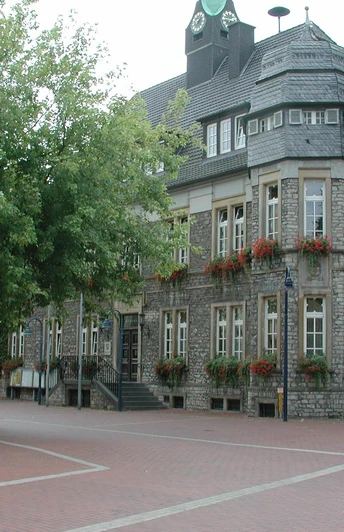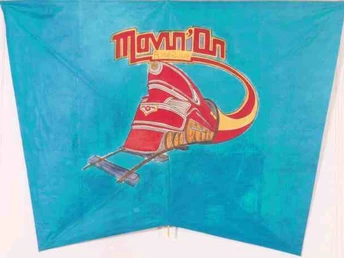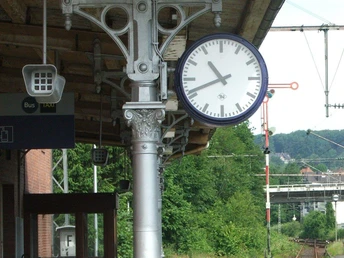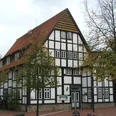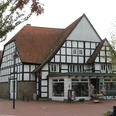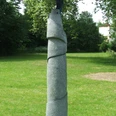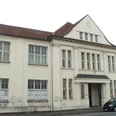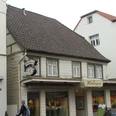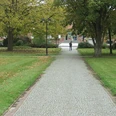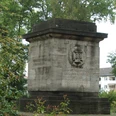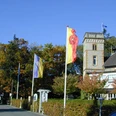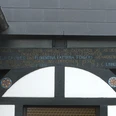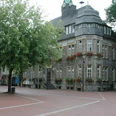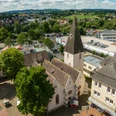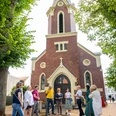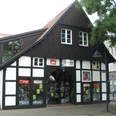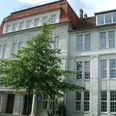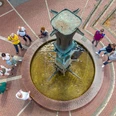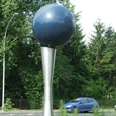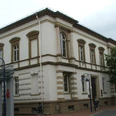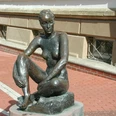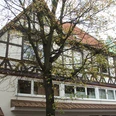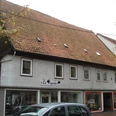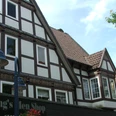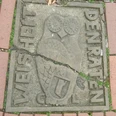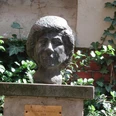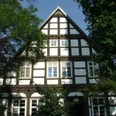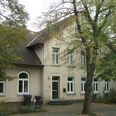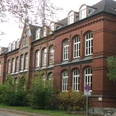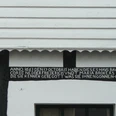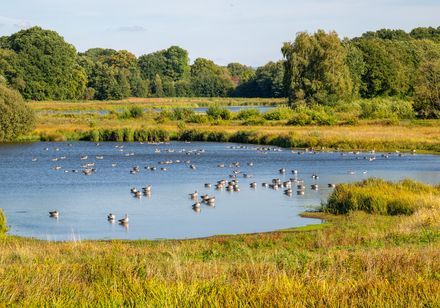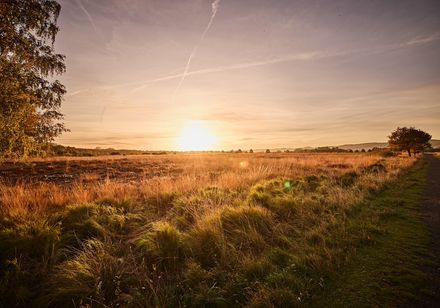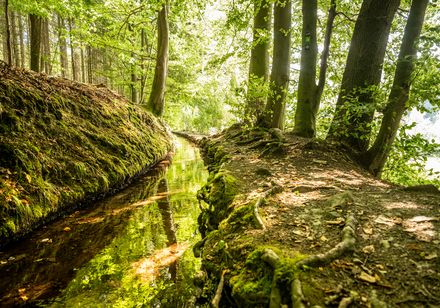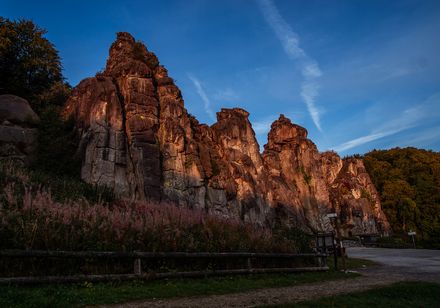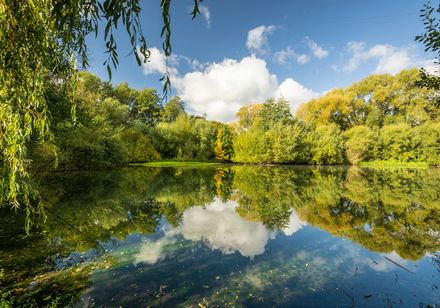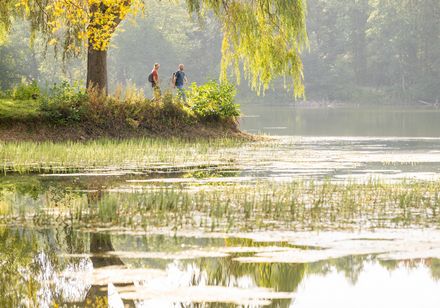- 1:45 h
- 3.53 km
- 10 m
- 10 m
- 96 m
- 102 m
- 6 m
- Start: Town hall
A look into the past
The exact origins of Lage are still unknown today, but urn graves and runic signs found during the construction of the Lage-Lemgo railroad (1897) and the old goods station (1874) lead to the assumption that people lived here around 4,000 years ago in the Stone and Bronze Ages.
Lage originally meant "in der Lohge". "Loh-orte" used to be settlements surrounded by woodland with a large clearing, usually near sacred sites. This could be a reference to the St. John's Stones, as St. John's customs have been passed down from Germanic mythological culture to this day. A reference to the market church, which is dedicated to St. John the Baptist, also seems likely. There used to be a St. John's house on the market square in Lage and the oldest fair in Lage took place on St. John's Day.
Today's town of Lage comprises the three old parishes of Lage, Stapelage and Heiden, which were founded between 800 and 1000 AD. Each parish has its own interesting history. The parish of Lage originated around 900 AD.Lage as a parish village was the spatial and economic center from the very beginning. Here in the Werre valley, the valley roads intersected with the military roads from the passes of the Teutoburg Forest (Dörenschlucht, Stapelager Schlucht and Oerlinghauser Schlucht). The old Roman military road under Drusus, which was built when the Romans set out from the Rhine to the Weser (from the Dörenschlucht gorge via Lage to Herford), is repeatedly mentioned under the name Hellweg.
In 1231, "dat Kerkspel tho der Lohge" included the villages of Oberdissen (Ohrsen), Wissinctorp (Wissentrup), Stadenhusen, Otenhusen and Potenhusen.
In 1390, the village "with the customs there" was pledged by the sovereign Count Simon III to a wealthy Lemgo merchant family. In return, the pledge holder had to build a stonework for Count Simon III, which was to be a "house of protection and need". It is assumed that this house was the castle in Lage, which was demolished by order of the Bishop of Paderborn during the Evenstein feud in 1409. The old field names and place names "Burgkamp", "Schlüsselburg" and "Burgstraße" provide further evidence of the old castle.
In the 16th century, the village developed into a "freyen Weichbild" with a market town. While in 1533 there is still talk of the "Dorpe" Lage, the "freye Weichbild" of 1559 already emphasizes the recognition of its full "equality with the town of Detmold", i.e. the existence of early municipal privileges such as market justice, customs there, mayor, council, electors and a marksmen's corporation.At the time of the 30 Years' War, there was a rampart with a moat around the round village. One indication of this today is the Rhienstrasse, which probably ran along the inside of the rampart. Only 28 burgher houses, a small dairy, a mill yard and the market church survived the 30 Years' War.
First Lage was a church village, later a "Flecken" with a town-like administration. As long as Lage was a "Flecken", spinning and weaving at home was the only secondary occupation of the farming community. Farmers were citizens who lived in the town but had their fields outside the town boundaries. During the heyday of the linen trade, Lage had the largest number of looms in Lippe. 612 master weavers and 473 assistants laid the foundations for the fame of Bielefeld linen on 808 looms. In 1609, this led to the envy of the merchants of Lemgo, who wanted to ban the "linen merchants" of Lagens from selling their goods.Economic hardship and a convenient location turned the town of Lage into a brick-making town from the end of the 18th century. The brickmakers' messengers were based here. On certain days from December to February, brickmakers from all over Lippe gathered on the market square to be recruited by a master brickmaker for one of the work groups. They left here to earn a living abroad, working in the Ruhr region, the Rhineland, the Netherlands, Denmark, Sweden and even Russia. Today, the small local museum in Lage and the Beermann steam brickworks in Lage-Hagen, which has been restored by the Landschaftsverband Westfalen-Lippe, are reminders of this time.Around 1850, the invention of the mechanical loom led to the decline of the industry that was so important for the employment of the people of Lage. A misguided social policy of the Lippe prince - the setting up of mechanical looms was banned in Lippe to prevent unemployment - resulted in the loss of Lippe linen to the competition. In addition, other trades - with a few exceptions - were not allowed to establish themselves, as this right was reserved for the townsfolk and Lage was only elevated to town status in 1843.
The decisive change from a farming town (the coat of arms still shows the plow in the field of ears) to an industrial town began at the end of the 19th century when the first railroad lines (Herford-Lage-Detmold 1880; Lage-Lemgo 1896; Lage-Bielefeld 1904) were built. Lage developed into the transportation hub of the Lippe region. The need to migrate ceased to exist as the new factories (1889 Lippische Zuckerfabrik; 1889 Lagenser Molkerei) created more and more jobs. The food and luxury food industry, which found an ideal location in Lage, should also be mentioned here. The local textile industry also became very important and was able to develop favorably despite the lack of raw materials, as Lage had a large supply of jobs and a favorable transport location. A third important branch of industry was the timber industry, especially the furniture industry.Today, there are a wide variety of medium-sized industries (wood industry, electrical engineering, mechanical engineering, etc.) in Lage.As a result of the municipal reorganization in 1970, the large municipality of Lage was formed from 14 villages. The result was a town with an area of 76 square kilometers and around 37,000 inhabitants. Today, Lage is known as a brick-making town, a sugar town (because of the sugar factory) and a town of sport. Many regional, national and international sporting events take place here.
Waypoints
Good to know
Best to visit
Directions
Tour information
Loop Road
Stop at an Inn
Equipment
Directions & Parking facilities
Additional information
Literature
License (master data)
Author´s Tip / Recommendation of the author
Map
